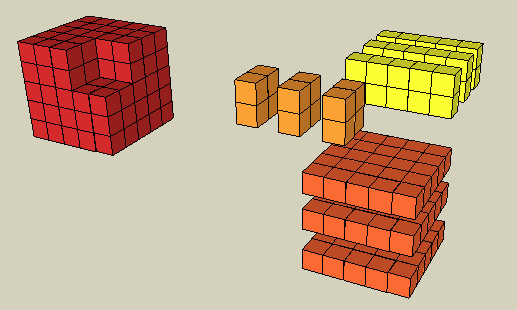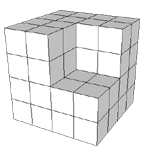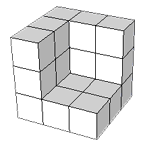| |||
| Math Central | Quandaries & Queries |
|
Question from Bill, a teacher: |
Hi Bill.
A difference of cubes is of course a perfect cube minus a perfect cube.
I assume your student already has the formula
a3 - b3 = (a - b)(a2 + ab + b2)
We can prove this using polynomial division.
First, we look at the roots of a3 - b3 and immediately we can see that if a = b, then a3 - b3 = 0, so (a-b) is a factor.
Next, rewrite it: a3 - b3 = a3 + 0a2b + 0ab2 - b3 and use synthetic (or long) division to find the other factor. I'll use long division:

You could do something very similar for a sum of cubes.
However, there is a geometric way of seeing this too, at least where a and b are positive and a > b:
For example, say a= 4 and b = 2. Here is 43 - 23:
and here is 33 - 23 :
Let's take apart 33 - 23 first. The red object is broken into the other colours:

So the red object is composed of the orange piece which is 32 plus the yellow piece which is 3x2 and the gold piece which is 22. So the original 33 - 13 equals the components 32 + 3x2 + 22. Now since (3-2) = 1, we can multiply by this and not change anything, so we've shown
33 - 23 = (3-2) (32 + 3x2 + 22)
But what about trying something harder, like 53 - 23?

We have the same breakdown, but there are 3 copies of everything! This makes sense because (5-2) = 3.
So we've shown that
53 - 23 = (5-2) (52 + 5x2 + 22)
just as the formula predicted and our long division proved algebraically.
If you look carefully at the last diagram, you can consider it as a3 - b3 and show that the number of copies is always (a-b), thus proving the general case.
I'd encourage your student to explore in this way the sum of cubes and see if she can come up with a similar algebraic and geometric solution.
Cheers,
Stephen La Rocque.
 |
||
Math Central is supported by the University of Regina and The Pacific Institute for the Mathematical Sciences.

